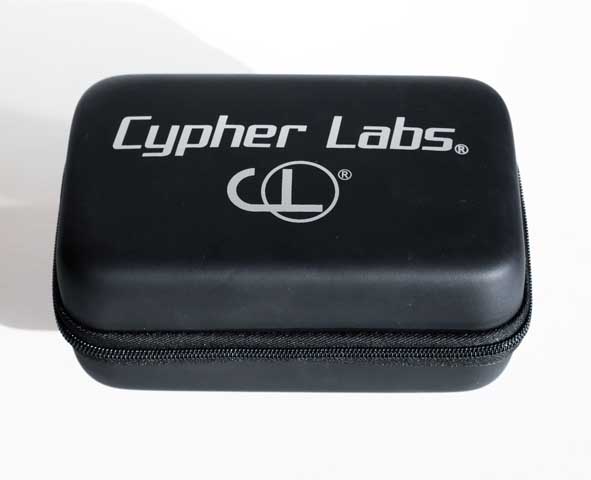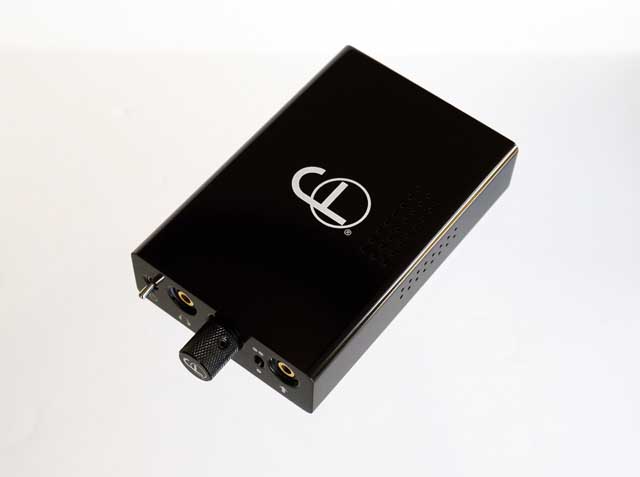Cypher Labs is best known for their line of portable solid state and desktop tube amplifiers, but until recently they’ve never had a portable tube amp. Enter the AlgoRhythm Trio, the latest portable from Cypher Labs. The Trio is a $599 portable amplifier that utilizes a single 6111 micro tube, but can it make a name for itself in the ever-growing market of portable amplifiers?
The Trio comes with the essentials to get you started. When you first open the box you’re presented with a rubber protective case. Contained within the case is the AlgoRhythm Trio, USB charging cable, AC power adapter, a 3.5mm interconnect, several elastic bands, and a small leather divider that can be placed between your source and the amp to prevent the two from rubbing. Cypher Labs also includes a convenient card containing information that may be useful to new owners, such as battery capacity, output at various loads, and details about the specific tubes. While not everyone will need to have this information handy, it’s nice to see that time was taken to provide it to those who do.

The Trio has a solid feel when held; it’s a device that will hold up well to months and years of use. The enclosure is constructed from a single block of aluminum and finished in a durable black coating. At one end of the device are the 3.5mm input and outputs, gain switch, power toggle, and volume potentiometer. At the opposite end is a Mini USB port for charging. Lastly, there is a set of ventilation openings on the front and side of the Trio to allow cool air inside for the tubes.
There are a number of markings on the device, but most are simply icons to indicate the function of the switches and 3.5mm jacks. The Cypher Labs logo can be found on the front and on the face of the volume pot, and device-specific information such as model and serial numbers can be found near the USB charging port. Aside from these markings, the device is completely void of any unnecessary artwork. The general lack of graphics combined with the svelte body gives off an overall understated feel to the Trio. It’s not uncommon to see over-designed and “shouty” products in the audio world, so it’s refreshing when a company focuses solely on what’s important, the sound.

The Trio is a quick amplifier. Cypher Labs designed the Trio around a Thompson 6111 tube, one that adds a pleasing touch of warmth to your source. On Cypher Labs’ site they call the Trio an amp “designed to deliver a rich warm tone” and that it has a “warm and smooth dark tonality.” When I read that description and compared it to what I hear coming from the amp, I was slightly baffled. The sound was smooth with a touch of warmth, but it certainly wasn’t something I’d call dark.
For listening I paired the Trio with the headphones in my collection with which I’m most familiar: the cicrumaural MrSpeakers Ether, the 1964 Ears 1964-Q CIEM, and the on-ear V-MODA M-80. I connected the Trio to my Questyle QP1R DAP, set it to low gain, and let the music flow.
First out of the stable was the Ether. It’s the least sensitive of the three and the headphone that I use most often when at home. With the Ether, the Trio felt like a hybrid amp rather than a full tube design. The amp is quick and delivers clean detail in the midrange with a relaxed treble. The tube element is clearly asserted in the mids and lows. Male vocals were rich and full bodied and the low end made its presence known without asserting authority over the rest of the range.
After the Ether I reached for the M-80. This is the headphone that I use 40 hours a week at the office. The very first thing I noticed was some noise coming from the Trio. The M-80 is a fairly efficient headphone and can be sensitive at times, so it’s no surprise that I notice the noise through it and not the Ether. The next thing that stood out to me was a mild ringing that occurred while turning the volume pot. I attributed this to the M-80s sensitivity and moved on.
I didn’t find the pairing of these two a good one. Adding warmth to the more natural and somewhat revealing M-80 detracted from my favorite aspects of the headphone and made it slightly congested. I concluded that the M-80 was a lost cause with the Trio and pulled out my IEMs.
The final headphone I used with the Trio was my 1964-Q. I wanted to get a feel for the amp when out and about so I grabbed the CIEM and headed out of the house. The 1964-Q is a sensitive IEM and the noise I heard with the M-80 was even more pronounced. Once music is playing the noise is difficult to notice, even on my most sensitive multi-driver BA CIEM.
I thoroughly enjoyed the combination of the warmer 1964-Q and the Trio with the right music. The weak point of my 1964-Q is their mid section and the Trio does a nice job compensating for their weakness. This combo worked best for tracks that possessed a rolled off treble and lacked an accentuated bass. Some of my favorite tracks were given new life through the Trio thanks to the rich mids and sweet, smooth presentation.

On their site, Cypher Labs quotes a battery life of up to 8 hours for the Trio, and when using low gain I was able to reach that mark. High gain will demand more battery draw and I found that I lost around 60-80 minutes of play time when used exclusively on high gain. On both settings the amp would run warmer than room temperature but never once felt hot to the touch.
Those looking for a tube amplifier that doesn’t break the bank and isn’t “too tubey” will find the AlgoRhythm Trio to be an excellent choice. For Cypher Labs’ first venture into portable tube amps, the Trio knocks it out of the park. While it may not pair well with every headphone on the market, it did a wonderful job with most of my headphones. Chances are good that it’ll pair with yours, and when it does, don’t be surprised to find a smile creeping across your face.
Price: $599
Technical Specifications:
Size: LxWxH 105mm x 69mm x 24mm x (118mm with knob) (4.125”x2.7”x0.875”)
Weight: 243g (8.6oz)
Frequency response: 30Hz-100kHz ±1dB
Output power:
220mW into 32Ω
140mW into 50Ω
80mW into 300Ω
40mW into 600Ω
<1 Ω Output Impedance Mini Tube: Thomson 6111 Made in France 2 Gain Levels: Low Gain -8db & High Gain +12db Power and Battery Built in Rechargeable Lithium-ion battery Sanyo UF103450P*2 4000mAH/3.7V Playtime: >8 hours
Recharge Time : <4 hours High quality AVX tantalum capacitors, with very low internal resistance to keep output impedance <1 Ω. Tube heaters on regulated 5V power supply Step-up converter 30V Discrete FET output stage +/-7.5V The CLAT6111 power circuit has 95% Synchronous rectification efficiency so that this amp can last 8hrs. Also its switching frequency is up to 1.2 MegaHertz (1.2MHz), much higher the human ear can detect (20KHz) to provide very pure and clean power.















Want to join discussion?
Feel free to contribute!